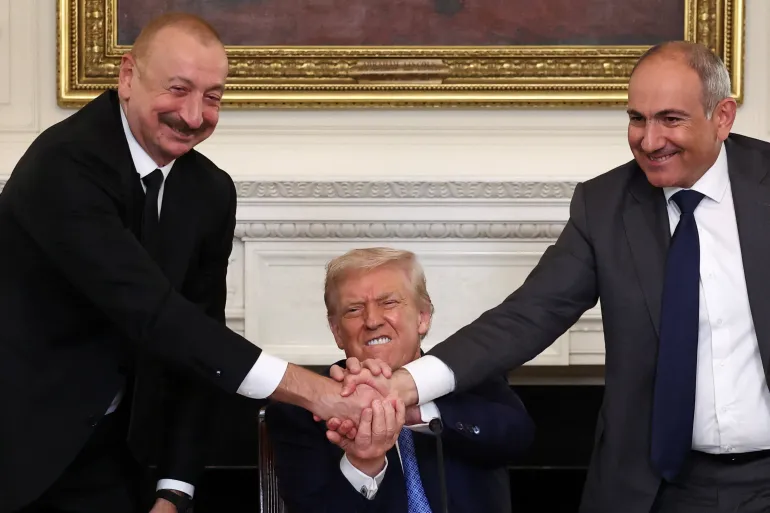
- TRIPP is primarily a U.S.-managed transit and trade corridor through Armenia’s Syunik province, linking Azerbaijan to Nakhchivan and Turkey, with a 99-year operational period, but without binding security guarantees for Armenia.
- The agreement sidelines Russia’s mediation role and the OSCE Minsk Group, creating a U.S.-controlled chokepoint between Russia and Iran while offering no restitution for displaced Armenians from Nagorno-Karabakh.
- Armenia’s stability under TRIPP depends on Azerbaijan’s restraint, risking sovereignty if enforcement mechanisms remain weak and lacking credible deterrence.
- Armenia has rapidly expanded defence ties with India, signing over $1.5 billion in contracts since 2022, including Akash missile systems, Pinaka rocket launchers, Swathi radars, and anti-drone technology.
The Deal That’s Being Sold as Peace
On 8 August 2025, the ornate halls of the White House became the stage for a much-publicised moment in Caucasus diplomacy. U.S. President Donald Trump, flanked by Armenian Prime Minister Nikol Pashinyan and Azerbaijani President Ilham Aliyev, unveiled the Trump Route for International Peace and Prosperity (TRIPP). The deal was presented as a diplomatic breakthrough that would end decades of hostility, “connect the region,” and “unlock prosperity” for all sides.
For television cameras and headline writers, the optics were perfect – three leaders shaking hands under the watchful eye of the U.S. flag, promising a new era. But beyond the ceremonial smiles lies a harsher reality: TRIPP is not a peace agreement in the traditional sense. It is a transit and trade arrangement, primarily designed to serve geopolitical interests that do not necessarily align with Armenia’s long-term security needs.
What TRIPP Is (and isn’t)
At its core, TRIPP establishes a transport corridor through Armenia’s Syunik province, linking mainland Azerbaijan to its exclave Nakhchivan and onwards to Turkey. Under the agreement, the United States would oversee the development and operations of this corridor for an extraordinary 99 years (source?) while nominally recognising Armenian sovereignty over it. In return, Washington has promised economic aid packages to both Armenia and Azerbaijan, coupled with infrastructure investments and trade facilitation measures.
The deal also shifts the diplomatic balance in the region by reducing Russia’s traditional role in Caucasus mediation and sidelining the OSCE Minsk Group framework. From Washington’s perspective, this is a geopolitical win and an American-managed corridor between Russia and Iran, cutting across a vital Eurasian junction.
However, the omissions in TRIPP are just as important as its inclusions. There are no binding security guarantees for Armenia’s borders. There is no restitution, compensation or justice for the more than 100,000 Armenians forcibly displaced from Nagorno-Karabakh in 2023. Enforcement mechanisms for violations remain vague, relying more on diplomatic goodwill than hard deterrence. In essence, TRIPP makes it easier for Azerbaijan to connect to Turkey, but does not make Armenia any safer from future coercion or military pressure.
The Strategic Weakness – Peace Without Power
The absence of hard security provisions means that Armenia’s stability under TRIPP depends entirely on Azerbaijan’s calculations – a dangerous gamble given recent history. The wars of 2020 and 2023 showed how quickly paper agreements can be disregarded when one side believes it has the military advantage. A corridor with foreign operational rights, without ironclad enforcement or a credible deterrent, risks becoming a sovereignty liability.
For Yerevan, the strategic takeaway should be clear: peace without power is temporary. TRIPP might lower tensions in the short term, but without parallel military strengthening, it risks locking Armenia into a position of dependency and strategic vulnerability.
Regional Power Play – And Impact of TRIPP
| Country | Potential Gains | Potential Risks |
| Iran | Reduced risk of border conflict | Corridor bypasses Iranian transit routes; U.S. presence near borders |
| Israel | Strengthened ties with Azerbaijan | Corridor under U.S. audit may limit covert logistics |
| Turkey | Realisation of the ‘Turan’ land bridge vision | Reduced leverage if Armenia retains snap-back rights |
| Central Asia | New trade route to Europe, bypassing Russia | Vulnerability to disruptions in Armenia |
| China | Predictable Caucasus trade lanes | U.S.-controlled chokepoint in Eurasia |
| France/EU | Diversified east–west trade corridor | Limited influence over governance and enforcement, |
| Russia | Temporary quiet in the Caucasus | Loss of mediation monopoly and CSTO credibility |
| United States | Strategic footprint between Russia & Iran | Responsibility for corridor stability without solving root causes |
This table reflects the strategic chessboard TRIPP creates. For Iran, bypassing its transport routes weakens its leverage; for Turkey, it advances a long-held pan-Turkic dream; for China, it offers trade stability but places a U.S.-monitored chokepoint on its Eurasian map. Each actor sees opportunities, but most also recognise vulnerabilities.
Armenia’s Defence Pivot – The Numbers Don’t Lie
Recognising that Russia’s security guarantees have weakened, Armenia has been rapidly diversifying its defence partnerships, with India emerging as the most important. Since 2022, Yerevan has signed over $1.5 billion in defence contracts with New Delhi. These include the Pinaka multi-barrel rocket launch systems, Swathi counter-battery radars, and advanced anti-drone technology.
In 2023, Armenia became the first foreign buyer of India’s Akash surface-to-air missile system, in a deal worth around INR 60 billion (~$720 million). Previous purchases included Swathi radars worth ~$40 million and Pinaka systems valued at $245-250 million. By 2024, India accounted for approximately 43% of Armenia’s total arms imports, a remarkable shift in just two years. These deals are not limited to equipment; they also encompass training, logistics support, and long-term sustainment, signalling a deepening strategic alignment.
For Armenia, TRIPP should be treated as a temporary de-escalation measure, with parallel military strengthening and safeguards such as snap-back rights, non-militarisation monitoring, and binding humanitarian provisions.
Deterrence is the Only Path
For Armenia, TRIPP should be treated as a temporary de-escalation tool, not a substitute for security. Its defence posture needs to evolve into three integrated layers:
- Air and Missile Defence: Expansion of Akash and Akash-NG systems, integrated with Swathi radars and electronic warfare capabilities.
- Precision Fires: Increased Pinaka regiments with guided munitions and loitering drones for deep-strike capabilities.
- Sustained Readiness: In-country maintenance hubs, forward ammunition stockpiles, and continuous training cycles with India.
Only such layered deterrence can ensure that Armenia has the means to defend its sovereignty if TRIPP’s promises falter.
Safeguards if TRIPP Moves Forward
If Armenia proceeds with TRIPP, it must do so with strict conditions: unequivocal legal sovereignty over the corridor, a snap-back mechanism to suspend access in case of Azerbaijani violations, constant monitoring to ensure non-militarisation, and binding humanitarian provisions including property restitution and heritage protection. Without these, TRIPP risks becoming an instrument of leverage against Armenia rather than a tool for peace.
Peace Without Power is a Pause
TRIPP will be hailed in Washington and Baku as a diplomatic win, but for Armenia, it is only a pause in hostilities. Sustainable peace requires hard power, and Armenia’s growing partnership with India offers a unique opportunity to build it. For Yerevan, the next decade should be about transforming this partnership into a robust security architecture – one that not only deters aggression but also strengthens Armenia’s geopolitical standing.
In the volatile Caucasus, peace without power is an illusion. Armenia’s survival and, by extension, the stability of the region, will depend on its ability to turn the current pause into a platform for enduring security.
The author is a Project & Program Management Consultant with expertise in strategy, planning, delivery and global deployments; and is deeply interested in geopolitics, defence, military affairs and foreign policies. Follow the author on X at @GeoBharatIntel. Views expressed are the author’s own.
